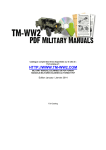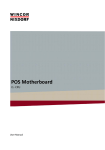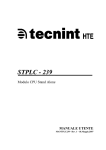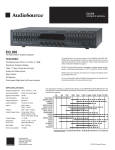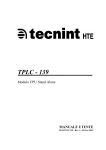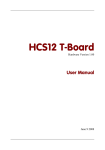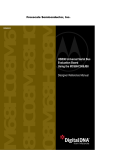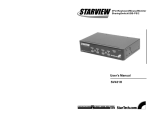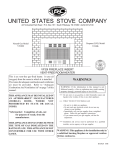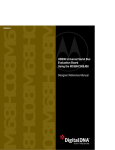Download User Manual
Transcript
HC08 Welcome Kit HardwareVersion 2.01 User Manual June 30 2003 HC08 Welcome Kit Copyright (C)2000-2003 by MCT Elektronikladen GbR Hohe Str. 9-13 D-04107 Leipzig Telefon: +49-(0)341-2118354 Fax: +49-(0)341-2118355 Email: [email protected] Web: http://www.elektronikladen.de/mct This manual and the product described herein were designed carefully by the manufacturer. We have made every effort to avoid mistakes but we cannot guarantee that it is 100% free of errors. The manufacturer's entire liability and your exclusive remedy shall be, at the manufacturer's option, return of the price paid or repair or replacement of the product. The manufacturer disclaims all other warranties, either expressed or implied, including but not limited to implied warranties of merchantability and fitness for a particular purpose, with respect to the product including accompanying written material, hardware, and firmware. In no event shall the manufacturer or its supplier be liable for any damages whatsoever (including, without limitation, damages for loss of business profits, business interruption, loss of business information, or other pecuniary loss) arising out of the use of or inability to use the product, even if the manufacturer has been advised of the possibility of such damages. The product is not designed, intended or authorized for use in applications in which the failure of the product could create a situation where personal injury or death may occur. Should you use the product for any such unintended or unauthorized application, you shall indemnify and hold the manufacturer and its suppliers harmless against all claims, even if such claim alleges that the manufacturer was negligent regarding the design or implementation of the product. Product features and prices may change without notice. All trademarks are property of their respective holders. User Manual Contents 1. Overview . . . . . . . . . . . . . . . . . . . . . . . . . . . . . . . . . . . . . . . . . . . . 3 Technical Data . . . . . . . . . . . . . . . . . . . . . . . . . . . . . . . . . . . . . . . . . 3 Package Contents .......................................4 2. Quick Start . . . . . . . . . . . . . . . . . . . . . . . . . . . . . . . . . . . . . . . . . . 5 3. Parts Location Diagram . . . . . . . . . . . . . . . . . . . . . . . . . . . . . . . . 7 4. Jumpers and Solder Bridges . . . . . . . . . . . . . . . . . . . . . . . . . . . . 9 Jumpers . . . . . . . . . . . . . . . . . . . . . . . . . . . . . . . . . . . . . . . . . . . . . . 9 Solder Bridges .........................................9 5. Connectors . . . . . . . . . . . . . . . . . . . . . . . . . . . . . . . . . . . . . . . . . 11 6. Circuit Description . . . . . . . . . . . . . . . . . . . . . . . . . . . . . . . . . . . 14 Schematic Diagram . . . . . . . . . . . . . . . . . . . . . . . . . . . . . . . . . . . . . 14 Controller Core and Input/Output . . . . . . . . . . . . . . . . . . . . . . . . . . . 14 ...................................... Monitor Mode Interface . . . . . . . . . . . . . . . . . . . . . . . . . . . . . . . . . . User RS232 Port . . . . . . . . . . . . . . . . . . . . . . . . . . . . . . . . . . . . . . . Power Supply . . . . . . . . . . . . . . . . . . . . . . . . . . . . . . . . . . . . . . . . . Clock Generation 15 15 17 17 7. Application Hints . . . . . . . . . . . . . . . . . . . . . . . . . . . . . . . . . . . . 18 Startup-Code . . . . . . . . . . . . . . . . . . . . . . . . . . . . . . . . . . . . . . . . . . 18 . . . . . . . . . . . . . . . . . . . . . . . . . . . . . . . . . . . . . . 18 Additional Information on the Web . . . . . . . . . . . . . . . . . . . . . . . . . . 19 Additional HC08 Development Tools . . . . . . . . . . . . . . . . . . . . . . . . 19 PLL Initialization 8. Flash Loader FL08 . . . . . . . . . . . . . . . . . . . . . . . . . . . . . . . . . . . 20 Overview . . . . . . . . . . . . . . . . . . . . . . . . . . . . . . . . . . . . . . . . . . . . 20 Serial Communication . . . . . . . . . . . . . . . . . . . . . . . . . . . . . . . . . . . 20 FL08 Commands . . . . . . . . . . . . . . . . . . . . . . . . . . . . . . . . . . . . . . . 21 Autostart Function . . . . . . . . . . . . . . . . . . . . . . . . . . . . . . . . . . . . . . 21 1 HC08 Welcome Kit Startup Behaviour . . . . . . . . . . . . . . . . . . . . . . . . . . . . . . . . . . . . . . 22 Redirected Interrupt Vectors . . . . . . . . . . . . . . . . . . . . . . . . . . . . . . . 22 9. Memory Map . . . . . . . . . . . . . . . . . . . . . . . . . . . . . . . . . . . . . . . 24 2 User Manual 1. Overview The HC08 Welcome Kit provides you with a small microcontroller board that helps to evaluate the Motorola MC68HC908GP32. It is a cost-effective, off-the-shelf solution which provides a stable hardware platform for starting an HC08 application development. The competitive price and the compact size of the evaluation board make it ideal also for low- to mid-volume series applications. A comprehensive range of development tools (debuggers, assemblers, C compilers) are available to help making software development for the HC08 an easy process. Technical Data w Motorola MC68HC908GP32 8-bit Microcontroller (QFP44) package, with up to 33 I/O-Pins w 9.8304 MHz Oscillator (removable, socketed), Bus Clock up to 8 MHz w alternatively: PLL-based clock generation with 32 kHz Crystal w 32 KB Flash Memory, 512 Byte RAM w SPI - synchronous serial interface w 4x 16-Bit Timer (Input Capture/Output Compare/PWM) w 8 Channel 8-Bit A/D-Converter w all I/O-Lines are available via header connectors on the board w Monitor Mode Interface for In-System Programming (ISP) w Advanced features: Remote Power-Cycle and Remote Break make debugging much easier w Serial Interface including RS232 driver to connect a PC or a serial LCD w Indicator LED w 5V On-Board Voltage Regulator and connector for Wall PowerPlug 3 HC08 Welcome Kit w Reset push button (Power-On Reset) w Wire-wrap area 6x12 w compact size: 100mm x 60mm (approx. 4" x 2.4") Package Contents w w w w w Evaluation Board with HC908GP32 RS232 Cable (Sub-D9) 9.8304 MHz canned oscillator integrated High-Speed Flash Loader FL08 User manual (this document), schematic diagram HC08 Welcome Kit V2.0 4 User Manual 2. Quick Start Nobody likes to read big manuals. For that reason we will summarize the most important things in the following section. If you need additional information, please refer to the more detailed sections of this manual. Here is how you can start: w Please check the board for any shipping damage w Check the Jumpers: the default position of JP1 (MON) and JP2 (AUTO) is open, JP3 (VENA) and JP4 (RRST) must be in position 1-2 w Check the solder bridges: factory default for BR1 and BR2 is position 1-2, BR3 is open, BR4 and BR5 are closed w Connect the Controller Module via RS232 to a PC. The connection between the HC08 Welcome Kit (connector X3) and the PC is simply made using the included flat ribbon cable. w Start a terminal program on the PC. An easy-to-use terminal program is OC-Console which is available at no charge from our Website! w Select a communication speed of 115200 Baud. Disable all hardware or software protocols. Activate the *-handshaking (the terminal must wait for the character "*" before sending another S-Record line) w Connect a Power supply of 8 to 12 VDC to X1 (central pin carries +5V, GND outside) w Now FL08 will start, a High-Speed Flash Loader software which was programmed into Flash before shipping w If necessary, erase the Flash memory using command "X" w Start the download using command "L" w Send the S-Record file (OC-Condole command "Transfer") 5 HC08 Welcome Kit w Now the program is being loaded into Flash. During this process, an increasing number of handshake characters becomes visible. After reception of an S9 line, the programm will be started w To restart the program (after reset) either type "G" or close the AUTO jumper (JP2). Note: the user program must start at address $8000 in this case. We hope you will enjoy working with the HC08 Welcome Kit! 6 User Manual 3. Parts Location Diagram Component side 7 HC08 Welcome Kit Solder side 8 User Manual 4. Jumpers and Solder Bridges To locate jumper positions, please refer to the parts location diagram (see above). Jumpers JP1: open* closed MON (Monitor Mode) User Mode (user program or FL08 Flash Loader) Monitor Mode (programming/debugging via MON08) JP2: open* closed AUTO (Autostart) start Flash Loader FL08 after Reset, FL08 immediately branches to address $8000 to execute user program JP3: 1-2* 2-3 VENA (Voltage Enable) standard control mode for IC4 reserved for LIN option JP4: 1-2* 2-3 RRST (Remote Reset) enable Remote Reset via serial /DTR line disable Remote Reset Solder Bridges The following solder bridges are located at the solder side of the board: BR1, BR2: 1-2* 2-3 RS232 TxD/RxD Select RS232 configured as "Device" (for connection to a PC etc.) RS232 configured as "Host" (for connection to a serial LCD etc.) 9 HC08 Welcome Kit BR3: open* closed BR4: open closed* BR5: open closed* LCD Power Supply (SER1) VCC not available on RS232 port (standard Sub-D connector layout) VCC available on RS232 port (at Pin 9 of the Sub-D connector) OSC external Oscillator IC3 delivers clock (required for Monitor Mode) Clock generation by 32 kHz crystal and PLL (remove IC3 in this case!) OSC reserved for LIN option Controller pin RxD is connected with RS232 transceiver IC2 * = Factory Default Setting 10 User Manual 5. Connectors Power Supply Connector X1 + central pin - outside Monitor Mode Connector X2 n.c. 1 2 n.c. PC_RxD 3 4 n.c. PC_TxD 5 6 n.c. n.c. 7 8 n.c. GND 9 10 n.c. X2 User RS232 Connector X3 n.c. 1 2 n.c. Rx (Tx) 3 4 n.c. Tx (Rx) 5 6 n.c. n.c. 7 8 (VCC) GND 9 10 n.c. X3 11 HC08 Welcome Kit Expansion Connector X4 VCC 1 2 VCC GND 3 4 /RST PTC0 5 6 PTC1 PTC2 7 8 PTC3 PTC4 9 10 PTC5 PTC6 11 12 n.c. TXD 13 14 RXD GND 15 16 /IRQ /SS 17 18 MISO MOSI 19 20 SPSCK T1CH0 21 22 T1CH1 T2CH0 23 24 T2CH1 GND 25 26 GND X4 12 User Manual Expansion Connector X5 VCC 1 2 VCC GND 3 4 n.c. n.c. 5 6 n.c. PTA7 7 8 PTA6 PTA5 9 10 PTA4 PTA3 11 12 PTA2 PTA1 13 14 PTA0 GND 15 16 VDDAD PTB7 17 18 PTB6 PTB5 19 20 PTB4 PTB3 21 22 PTB2 PTB1 23 24 PTB0 GND 25 26 GND X5 13 HC08 Welcome Kit 6. Circuit Description Schematic Diagram The schematic diagram of the HC08 Welcome Kit is available as a separate document to ensure optimum visibility of all details. Controller Core and Input/Output The Microcontroller HC908GP32 needs only a few external components. Many peripheral functions, such as SCI, Analog/DigitalConverter and 32 KB of Flash Memory, are integrated on-chip. The HC908GP32 is offered in several packages. The HC08 Welcome Kit uses the 44-pin, QFP version of the 68HC908. This package has four more I/O pins than the DIP40 version. The operating voltage for the HC08 Welcome Kit is 5V, though the MCU can operate down to 3V (see data sheet for details). The reset system of the HC08 is different from other Motorola Microcontrollers (HC11, HC12). For example, the capacitor C6 on the reset pin of this circuit could never be used in an HC11 system. The HC908GP32 has an integrated LVI (low voltage inhibit) circuit, so an external reset controller is not required. As an optical indicator, a LED is connected to port pin PTC2. A driver circuit is not required because this port pin has a drive capability of up to 25mA. The I/O pins of the microcontroller are accessible on the expansion connectors X4 and X5. When connecting any external components, the requirements to activate the Monitor Mode should be considered (see below). 14 User Manual Clock Generation The oscillator IC3 generates a frequency of 9.8304 MHz. This clock is delivered to the OSC1 input of the microcontroller. The solder bridge BR4 must be open in this mode. The external clock from IC3 is required for Monitor Mode operation (programming, debugging via MON08), but can also be used for normal operation mode, i.e. running a user program (User Mode). Alternatively, the PLL module of the HC908GP32 can be used as the clock source. For this purpose, Q1, C1, C2, R1 and R2, together with the circuitry in the controller, form a Pierce-Oscillator which is generating a 32768 Hz clock. This clock is the input signal for the PLL, which produces the internal bus clock (up to 8 MHz). The parts R3, C3 and C4 form a filter combination for the PLL. In order to activate the PLL mode, the "canned" oscillator IC3 must be removed and solder bridge BR4 must be closed. The HC08 Welcome Kit is shipped with the High-Speed Flash Loader FL08 residing in Flash memory. FL08 uses the PLL to generate a bus clock of 7.3728 MHz. To utilize the PLL, some initialization steps are required. Please refer to the HC908GP32 data book for a comprehensive discussion of the PLL functions. For your convenience, a setup example is provided in the "Application Hints" section of this manual. Monitor Mode Interface For the purpose of Flash programming and software debugging, the HC908GP32 makes use of a special operating mode named "Monitor Mode". The difference between the Monitor Mode and the normal User Mode, is that firmware in the GP32's internal ROM is executed instead of the user's program. At first, this firmware examines a set of I/O pins which are used to select some operating parameters. Finally, this firmware establishes an asynchronous serial interface function on the port pin PTA0. This interface works bidirectionally (half duplex) and corresponds to the usual RS232 conventions. The baud rate is 9600 Baud. Besides the appropriate clock (9.8304 MHz), a number of port 15 HC08 Welcome Kit pins must be connected to certain logic levels, as summarized in the following table: Port Level PTA0 H PTA7 L PTC0 H PTC1 L PTC3 H Monitor Mode Levels on Ports A and C The monitor mode interface circuit on the evaluation board produces these levels using five pull up or pull down resistors. Apart from the above requirements it is further necessary to supply the /IRQ pin of the microcontroller with a higher voltage (in the range of approx. 7 to 10V) to enter Monitor Mode. This voltage is generated by the charge pump of the RS232 transceiver (IC2) and limited to 8.2V using the Zener diode D4. JP1 (MON) must be set, in order to apply this higher voltage to /IRQ. The connection of the Monitor Mode interface to the PC is made via X2. A ribbon cable with a 10-pin female header connector at the device end and a 9-pin Sub-D connector at the PC end can be used. The pinout scheme of the cable is shown in the following table: X2 Pin USB08 MONI PC RS232 Sub-D9 Pin 3 T1OUT RxD 2 5 R1IN TxD 3 9 GND GND 5 Pin configuration of the Monitor Mode cable 16 User Manual User RS232 Port In contrast to the serial Monitor Mode interface, the user RS232 port incorporates separate send and receive lines. The HC908GP32 has a SCI hardware module for asynchronous serial communication, the related pin names being TXD (send) and RXD (receive). X3 is the user RS232 port connector. For a connection to a PC, the same kind of cable is used as for the monitor mode connection. The solder bridges BR1 and BR2 on the solder side of the PCB have to be set to position 1-2. In this configuration, the PC works as a host, the HC08 Welcome Kit board represents the device side. The reverse case happens if a serial LC display is to be operated at the user RS232 port. In this configuration, the HC08 Welcome Kit board is the host and the LCD module represents the device side. The necessary RxD/TxD crossing can be done externally or by setting the solder bridges BR1/BR2 to position 2-3. At the same time, the serial LCD can be supplied with operating voltage by closing solder bridge BR3 (Note: this option is a deviation from the standard RS232 connector layout!). Serial alphanumeric LC displays are offered by several vendors. We particularly recommend LC displays from Matrix Orbital (see http://www.matrix-orbital.com). Power Supply Voltage regulator IC4 supplies 5V to the board from a DC voltage of between 8 and 12V supplied to the power input connector X1. IC4 is rated for up to 1 ampere and thus should be more than adequate even with no special cooling measures taken. The load current of the board is well less than 100mA. 17 HC08 Welcome Kit 7. Application Hints In this section some details will be given on how to program the HC908GP32 in general and the HC08 Welcome Kit in particular. Please be aware that, even if this manual can provide some specific hints, it is impossible to cover all kinds of knowledge and techniques required to design a microcontroller program. Please refer to the data sheets of the silicon vendors and to the manuals of the software tools you use to find additional help. Startup-Code Every microcontroller program starts with a number of hardware initialization commands. For an HC908GP32 application program, only a small number of issues are important: w setting the Stack Pointer w selecting the proper base clock for the SCI (if used) w disabling (or using) the COP Watchdog timer The following assembly language sequence shows an example: entry ldhx #$00ff txs mov #$01,CONFIG2 mov #$01,CONFIG1 ; ; ; ; Program Entry Point Init Stack Pointer SCI uses Bus Clock Disable Watchdog PLL Initialization An application program can use the PLL to generate the bus clock. In this case, the program must take care to properly initialize the PLL module. The following program listing shows an example of how to initialize a system with a bus clock rate of 7.3728 MHz (as used by FL08): 18 User Manual PCTL PBWC PMSH PMSL PMRS PMDS EQU EQU EQU EQU EQU EQU $36 $37 $38 $39 $3A $3B BCS PLLON LOCK AUTO EQU EQU EQU EQU 4 5 6 7 INITPLL BCLR BCLR MOV MOV MOV MOV MOV LDA BSET BSET W4LOCK BRCLR BSET BCS,PCTL PLLON,PCTL #$02,PCTL #$01,PMDS #$03,PMSH #$84,PMSL #$C0,PMRS PCTL AUTO,PBWC PLLON,PCTL LOCK,PBWC,W4LOCK BCS,PCTL ;Select external Clock ;Turn PLL off ;P=0, E=2 ;R=1 ;N=900 ;L=192 ;clear PLLF ;Automatic bandwidth control ;Turn PLL on ;Wait for lock ;Select PLL Clock Additional Information on the Web Additional information about hard- and software of the HC08 Welcome Kit will be published on our Website, as it becomes available: http://www.elektronikladen.de/en_kit08.html Additional HC08 Development Tools Motorola provides free development tools for the HC08 microcontrollers (assembler, programmer, debugger, etc.). Please check the following Web links: http://www.motorola.com/mcu/ http://www.pemicro.com/ics08/ 19 HC08 Welcome Kit 8. Flash Loader FL08 Overview The Flash Loader FL08 was implemented to simplify the download of application programs in S19 format. The HC908GP32 provides a special mode for download and debugging called monitor mode. Unfortunately, using monitor mode requires a number of prerequisites, e.g. the presence of an external oscillator. Using the Flash Loader FL08 has the following advantages: w no mode change required to switch between monitor and user mode; no need to change jumpers or clock source w the same RS232 interface can be used for download and normal program operation w fast download using 115200 Baud w if AUTO jumper is set, the user program will be invoked automatically after reset w easy system initialisation w 7.3728 MHz bus clock (generated by the PLL from a 32 kHz clock crystal) w all interrupt vectors are available (redirected to internal RAM) The drawback of using FL08 is the dedication of resources (FL08 occupies a part of the MCU's memory) and the limitation of debugging capabilities (full debugging features only avaliable in monitor mode). Serial Communication FL08 communicates over the RS232 interface (SCI on X3) with a rate of 115200 Baud. Further settings are: 8N1, no hardware or software handshake, no protocol. 20 User Manual FL08 Commands After startup FL08 sends a welcome message over the serial interface and awaits one of the following user commands: X - Mass Erase Erases the whole Flash memory (the protected FL08 code remains unchanged). G - Go Starts the application program by jumping to address $8000. L - Load Loads a file in Motorola S-Record format into the microcontroller's Flash memory. Each S1-Record must not contain more than 32 data bytes. If a certain Flash page is accessed for the first time during loading, this Flash page (128 bytes) will be erased in the first step. Therefore it is not required to perform a mass erase command before loading. The terminal program which sends the S-Records must wait for the handshake character (*) before transmitting the next line. As soon as the download sequence is terminated by an S9-Record containing an address not equal to zero, the application program will be started automatically by jumping to the given address. If no address is specified, the program can be started manually with the G command or after reset by the autostart function. In this case, the program must start at address $8000. Autostart Function After reset, the Flash Loader FL08 detects if the AUTO jumper (JP2) is set, connecting the port pins PTC2 and PTC3. If this is the case, FL08 immediately jumps to memory address $8000. This feature allows starting an application program without modifying the reset vector, which resides in the protected Flash boot block. 21 HC08 Welcome Kit Startup Behaviour After reset, FL08 executes a number of initialization steps, which can have effect on the application program: w w w w w CONFIG1 = $01 (Watchdog disabled) CONFIG2 = $01 (SCI uses bus clock) PLL generates 7.3728 MHz bus clock SCI active using 115200 Baud (polling mode) stack from $0200 downward Redirected Interrupt Vectors The interrupt vectors of the HC08 are located at the top of the 64 KB address space, i.e. within the write protected Flash Loader code. To allow interrupt functions in an application program, the Flash Loader redirects all interrupt vectors (except the reset vector) to addresses within internal RAM. This scheme is similar to the operation of the HC11 in Special Bootstrap Mode. The application program sets the required interrupt vector during runtime (before global interrupt enable!) by placing a jump instruction into the RAM pseudo vector. Example: to use the IRQ interrupt, the application must perform the following steps: lda sta ldhx sthx #$CC $023A #isrFunc $023B ; ; ; ; JMP Opcode IRQ Pseudo Vector Jump Address IRQ Pseudo Vector + 1 For C programs, the following code sequence is applicable: // install IRQ pseudo vector in RAM // (if running with FL08) *((unsigned char *)0x023a) = 0xCC; // JMP opcode *((void (**)(void))0x023b) = isrFunc; 22 User Manual The following table summarizes all vector addresses (original and redirected) for the HC908GP32: HC08 Vector Address Redirected Address Interrupt Vector $FFDC $020D Timebase $FFDE $0210 ADC $FFE0 $0213 Keyboard $FFE2 $0216 SCI Tx $FFE4 $0219 SCI Rx $FFE6 $021C SCI Error $FFE8 $021F SPI Tx $FFEA $0222 SPI Rx $FFEC $0225 TIM2 Overflow $FFEE $0228 TIM2 Channel 1 $FFF0 $022B TIM2 Channel 0 $FFF2 $022E TIM1 Overflow $FFF4 $0231 TIM1 Channel 1 $FFF6 $0234 TIM1 Channel 0 $FFF8 $0237 PLL $FFFA $023A /IRQ $FFFC $023D SWI $FFFE ($F000) Reset 23 HC08 Welcome Kit 9. Memory Map From To 0x0000 0x003F 0x0040 0x023F 0x0240 0x7FFF Size Usage 64 Byte Control Registers 512 Byte RAM (FL08 redirected interrupt vectors from $020D) reserved 0x8000 0xEFFF 28672 Byte Flash Memory, 28 KB free for user application 0xF000 0xFDFF 3584 Byte Flash Memory, 3.5 KB used by Flash Loader FL08 0xFE00 0xFFDB Control Registers and Monitor ROM Code 0xFFDC 0xFFFF 36 Byte Interrupt Vector Table (Flash) Memory Map of the HC908GP32 (with FL08) For details about the Memory Map of the Microcontroller and information on addresses of Control Registers and Interrupt Vectors, please see the Motorola Data Book MC68HC908GP32 Technical Data. 24


























![HC08 Welcome Kit V2.01 Benutzerhandbuch (dt.) [PDF/1376KB]](http://vs1.manualzilla.com/store/data/006791091_1-033a0e255e026b3e3e89041623448bc2-150x150.png)
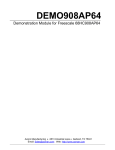
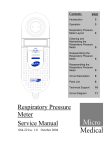
![[DRAFT] DEMO908JL16 User`s Manual](http://vs1.manualzilla.com/store/data/005639706_1-2a84cd2ce2f0b318fdb7aae7896f2a79-150x150.png)
